6 Ways B2B Retailers Can Use E-commerce Personalization Software to Boost Sales
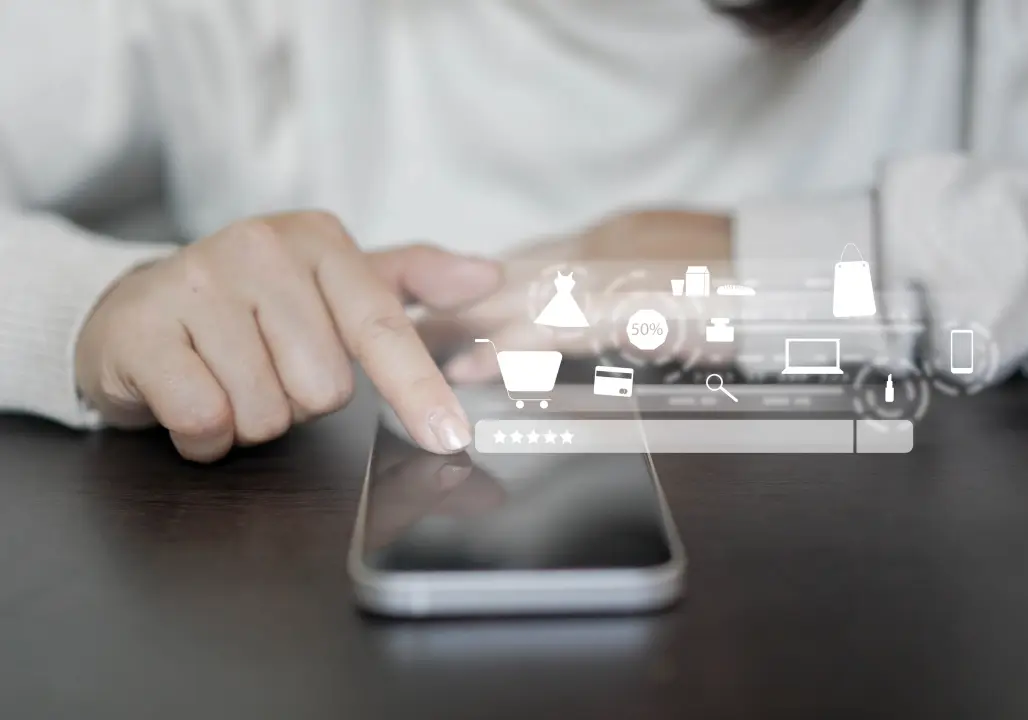
Personalization, in the broadest sense, has always been a critical element in sales. Think about your best experiences as a retail shopper when a store created an inviting experience for you. Perhaps a great salesperson not only helped you find the product you were looking for, they also pointed you to alternatives or accessories that made the purchase even more rewarding.
As more shopping has moved online – accelerated by the pandemic – personalization in e-commerce has been the key to translating great shopping experiences into the digital world. In fact, B2C retailers, who were some of the earliest adopters of digital personalization strategies, raised the level of customer expectations and set the example for all of e-commerce to follow, including B2B sales.
Consider these e-commerce personalization stats – according to McKinsey : 71 percent of consumers expect companies to deliver personalized interactions, and 76 percent get frustrated when this doesn’t happen. And companies that excel at personalization generate 40 percent more revenue from those activities compared to average players.
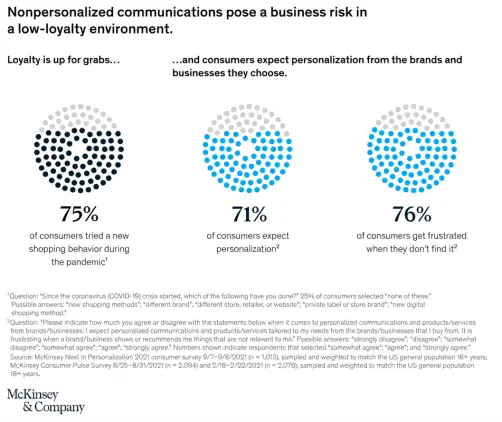
Today, online personalization is expected by e-commerce customers everywhere, and in the world of B2B where the buying process can be particularly complex, there are numerous use cases for optimizing the sales process with personalization along the entire customer journey.
Personalization can take many forms, starting with simple things such as a personal address in an email or a personal, handwritten card that is enclosed in a shipped package. Ideally, personalization is infused into every step of the customer journey – attracting new customers to your e-commerce site, keeping them engaged while they’re there, driving conversions, and building loyalty. Ideally, this process results in repeat purchases and builds brand advocates.
The secret to success with personalization is knowing how to show customers just the right products at the just the right time in their online shopping journey – and delivering it all with a top-notch digital experience.
This is where AI e-commerce personalization – with an experience optimization engine that learns from customer behaviors and other data points – is your ace in the hole, enabling you to win the hearts and minds of customers and sell more products in a way that no static product catalogue ever could.
Here are some e-commerce personalization examples that illustrate six great ways you can use personalization to win customers, drive them to purchase more and keep them coming back. We'll conclude with a real-world customer case study that demonstrates the importance of personalization in e-commerce and how it helped one B2B company maximize conversions and improve marketing agility.
1. Help shoppers discover new products: upsell in the shopping cart
Personalization can evoke positive feelings about your brand by associating it with a great shopping experience. For example, when shopping in the brick-and-mortar world, there’s an exciting feeling of serendipity when you come across a new product you love – especially when you didn’t realize you were looking for it. For many people that’s half the fun of shopping, as it taps into our deepest hunter-gatherer instincts and gives us a feeling of success and good fortune. It also creates an immediate connection with the brand and the store that’s selling it.
For online consumer retailers and B2B sellers, re-creating that serendipitous shopping experience with your e-commerce software is one key to driving conversions and winning loyal fans who keep coming back to your e-commerce website.
A great way to get instant results from personalization is to create the e-commerce equivalent of the product displays an in-person retail shopper might find at the check-out stand – the range of unique gadgets, accessories, and tasty morsels you didn’t come shopping for, but now can’t do without.
With website personalization tools, you can deliver highly targeted pop-up recommendations that trigger when products are added to the customer’s shopping cart. The pop-ups feature related items the customer may have overlooked while shopping, such as accessories or other products from the same product line.
For example, someone purchasing a printer for their office may also need paper, printer cartridges, a printer stand – even office furniture. Someone shopping for clothing may be enticed by a matching scarf, pair of shoes or other products from the same brand or product line, such as a jacket or sweater to match their outfit or work uniform.
These personalization examples give customers the positive experience of serendipitous discovery and prevent them from forgetting items they might need (which helps build loyalty and trust), and it gives brands the opportunity to increase the average shopping cart order value.
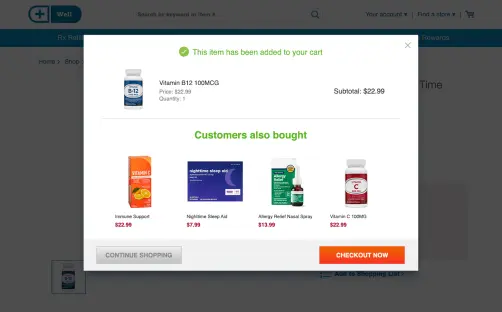
Example of e-commerce website personalization tools for shopping carts.
2. Use e-commerce intelligence to deliver personalized content
Much of the online shopping experience, particularly for B2B customers, has often been more of a search function than a shopping function. The trouble with that is that customers are bypassing a lot of great products they might have purchased had they known they were available. Here’s an area where B2B e-commerce sellers can learn from the website personalization examples set by their B2C retail counterparts – both in stores and online.
One reason the most successful brick-and-mortar retail brands consistently outsell their competition is because they have top-notch salespeople on the floor – guiding customers to products that meet their needs and up-selling with matching products and accessories that round out their purchase. In the e-commerce world, particularly as the pandemic pushed more shopping online than ever before, the most successful B2C and B2B brands responded by upping their game, finding ways to provide personalized shopping experiences that simulate those of the brick-and-mortar world.
The first point of contact for e-commerce buyers is the home page. Your customer may come to your site looking for one particular item, yet your product catalogue likely contains dozens, if not hundreds or thousands of unique items that the customer might miss entirely unless you use personalization.
Like a great in-store retail clerk, personalization allows you to turn any type of content or banner into dynamic content that is optimized and tailored to each unique customer coming to your site. The personalization engine gathers real-time data as the customer shops, based on their on-site behavior, clicks, and location (geospatial data). This information provides clues to the shopper’s preferences or needs and can indicate the types of products that might be most relevant to them.
Combining that key information with additional data – such as current industry trends, the latest fashions or what season it is in their region – is how AI in e-commerce enables even more personalization, delivering highly relevant, dynamic content on your homepage. That content might show new products or direct visitors to related content on your website, such as a special area for their audience segment, or how-to videos based on the products they’re considering.
For example, someone shopping for hiking boots in Oregon in March might also want to consider rain gear or waterproof boots or see a video showcasing “the best hiking trails” in their vicinity ( shoppable videos can highlight additional products in your catalogue). Someone in Minnesota shopping for swimsuits in November might be planning a winter vacation to a tropical climate – a perfect opportunity to showcase travel partners or sunglasses. A person looking for medical scrubs might benefit from seeing PPE, supportive shoes or the latest smartwatch to help them stay connected on the job.
This continuous flow of personalization information from the customer and to the customer enables a sort of e-dialogue that guides customers toward products they are more likely to buy or add to a wish list. It’s an example of personalization in e-commerce creating a positive shopping experience that builds brand loyalty and evokes the feeling of having received outstanding customer service – all of which keep customers coming back.
The data a brand collects over time about its customers’ shopping habits provides valuable insights into individual user preferences and helps the AI become even more accurate and responsive. With a personalization engine that helps you gather this data, your marketers can create specialized content for targeted audiences based on signals like inferred occupation or users’ affinities for specific styles, brands, price ranges, even colors. This information can be used to send highly effective recommendations and “special offers,” such as discounts, that drive conversions.
Among the many benefits of personalization in e-commerce, this affinity strategy improves the quantity and quality of interactions, driving better customer experiences now and enabling your brand to track shifts over time and respond quickly to changing user preferences.
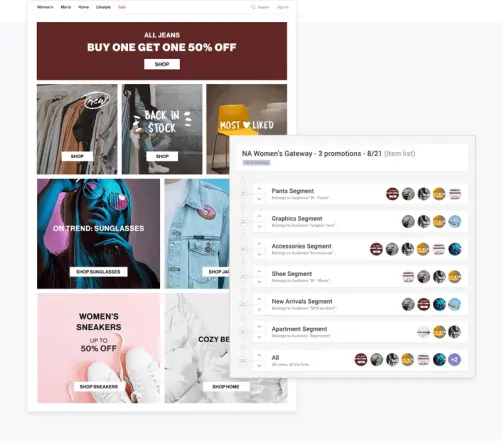
3. Customize the shopping experience with personalized sorting
Whether B2C or B2B, many brands find their customers go immediately to the product pages for items or categories of items they are looking for. But if you have a large catalogue, the customer may be scrolling through page after page of tangentially related products to find the right one.
With personalization, a deep-learning-based algorithm customizes the shopping experience by automatically ranking and re-ordering the results on product pages to show the specific products an individual shopper is most likely to interact with first. It might show products in a given category, based on the customer’s usage data, and as the customer shops, item ordering becomes even more targeted and relevant. This helps the customer quickly find what they’re looking for and enables brands to showcase and upsell more high-value items. For example, Bosch uses AI-personalization to rank products and improve relevance for target groups, such as carpenters and drywallers on their Power Tools website.

Every customer journey is different, as are their behaviors and shopping experiences on different devices. Personalization allows you to meet customers where they prefer to shop, carrying through their preferences across your desktop website, your mobile site and into your mobile apps, where text and social interactions can deepen the experience and customer relationship – and drive conversions.
4. Welcome new visitors and keep them coming back with personalized messages
When a potential new customer visits your website for the first time, personalization is a green field of possibility – and so is the customer’s relationship with your brand. One way to begin the courting process is by delivering content that helps you get to know them better.
For example, you might show them a pop up or bar across the bottom of the visible screen inviting them to “Find your size” or “Take our quiz” to begin customizing their shopping experience and gathering important data on gender, size, product preferences, etc. This not only informs your AI personalization and experience optimization engine , it also gives you valuable first-party data that customers willingly share with you in order to gain access to information or special offers.
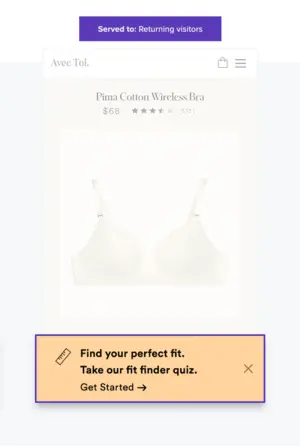
Marketers can set up different personalized messages based on customer audiences or segments and the CMS uses personalization, based on the visitor’s behavior on the website, to quickly identify which personalized messages or calls to action are most relevant for the new shopper. By prioritizing different messages for different segments marketers can create unique, user-focused shopping experiences that immediately get the customer relationship off to a great start and begin building long-time fans.
People like to “shop around,” and with so many choices out there, your website is probably not the only one they’ll be visiting. Personalization can create a more alluring experience for returning customers who didn’t make purchases during their first visit. It can also encourage shoppers who are indecisive to take the next step.
For example, if someone has viewed one or more products several times but just can’t seem to decide what to put in the shopping cart – or they put something in the cart but aren’t finalizing the purchase – your site can give them a pop-up, banner or message offering a discount or “Free shipping and free returns” to help them move to a decision and complete the purchase. Customers who return after previously abandoning their shopping cart are more often moved to purchase when brands sweeten the deal just a little bit.
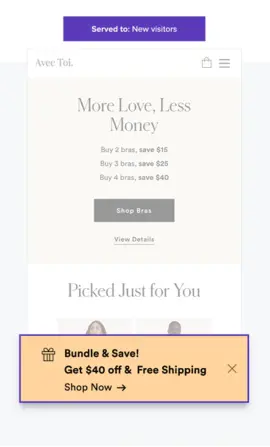
5. Nudge customers with abandoned shopping carts (and inspire the purchase)
Another way to use personalization to address shopping cart abandonment is via email. If your customer has provided their email address (for example, in the course of a previous purchase, to get the results of a quiz or gain access to a special offer or discount), the CMS can trigger an automated email – after a set period of time – to remind them of what’s in their cart and even make additional product recommendations that match or augment those products.
Marketers can set up the email template in the CMS, and the personalization engine automatically applies the relevant messaging, subject lines and optimized recommendations to entice the customer back to your website. Triggered emails that are optimized for each user – reminding them of both the items waiting in their cart and other recommendations – have been shown to increase conversions, purchase rate and average order value.
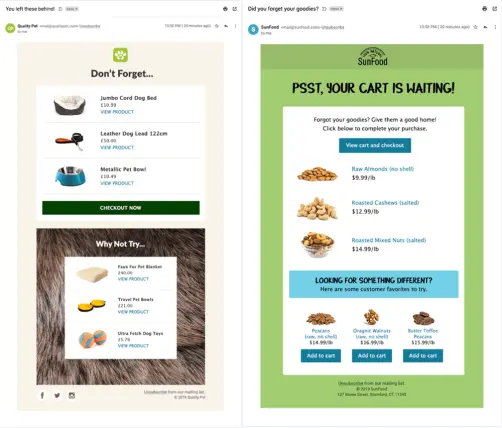
6. Keep customers informed when out-of-stock products are available again
If a shopper is looking for a particular item but it is no longer available in the size or options they want, giving them the opportunity to be notified as soon as the product is available is another great way to have the customer opt into your communication. From there, you can trigger a personalized email to automatically be sent to the customer notifying them of availability.
Likewise, some shoppers will keep looking around until they find a price point that suits them on a specific item. Giving the customer the opportunity to provide their email in order to be notified when there is a price drop is an excellent way to engage them in future communication. Marketers can set up a price-drop email campaign that includes a specific minimum purchase price. As soon as the price is reduced, the personalization engine sends out an email to notify the customer – converting abandoners into buyers and long-term fans.
While B2C e-tailers were some of the earliest adopters of these personalization strategies, all of these scenarios are just as applicable to B2B e-commerce sellers. And because many B2B e-commerce sites have yet to tap into the power of personalization – to go beyond the static product catalogue delivered by many types of e-commerce software and provide dynamic, compelling digital experiences for their customers – B2B brands that engage now can get a huge jump on the competition.
Now let’s dive a bit deeper into a real B2B customer success story. One of the best B2B website personalization examples is Eppendorf – a company that saw dramatic improvements in conversions and marketing agility from using Crownpeak’s Experience Optimization Engine to drive personalized experiences for their customers.
How Eppendorf optimized B2B conversions with AI e-commerce personalization and dynamic content
The Eppendorf Group is a leading life sciences company that develops and sells devices, consumables and services for liquid handling, sample handling and cell handling for use in laboratories worldwide. Their international e-business consists of 31 local websites in 12 languages, including 24 sites with online shops for B2B customers.
Eppendorf wanted to become a leader in the use of content-driven commerce and AI-powered personalization to optimize the B2B e-commerce experience across their digital properties. With a large and complex product range, they recognized the need to better understand and support their customers throughout the buy-cycle, enrich the customer experience and improve business outcomes by reducing cart abandonment and optimizing conversions.
They selected the Crownpeak DXP and Experience Optimization Engine for its ability to seamlessly integrate with their existing SAP Commerce Cloud, to create content-rich online stores that could be managed in-house by the content team, and for Crownpeak’s market-leading capabilities for tailoring real-time customer experiences.
“"By deploying targeted promotions through Crownpeak’s Experience Optimization Engine we’ve been able to minimize cart-abandonment and optimize conversions – achieving an average conversion rate of 15%.” Antje Pfeifer, Online Content Manager for Eppendorf. ”
Maximizing conversions and boosting marketing agility
Achieved 15% conversions on abandoned carts: “We were able to significantly decrease cart abandonment and increase our conversion rate to 15% by deploying targeted promotions to users demonstrating an intent to exit a sale. Overall, every seventh customer who had moved to abandon a purchase was encouraged to complete the sale,” said Pfeifer.
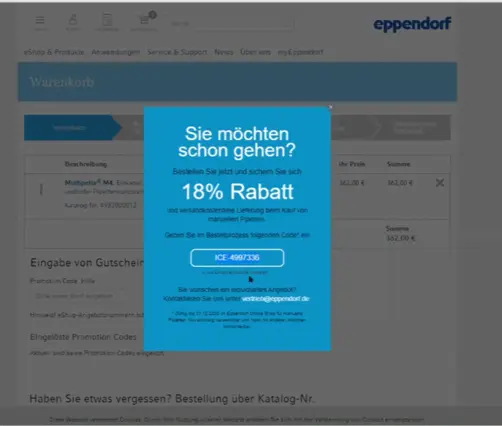
Reinforced user centricity: “B2B sales can be complex, and our products often require a lot of advice. When users were unable to make a decision, it was causing them to abandon purchases. With Crownpeak’s Experience Optimization Engine, we’re now able to react to signals – such as a lengthy “dwell time” – that may indicate a friction point in the buying process and send targeted invitations to speak to one of our sales consultants.”
Fast and easy content management by business users: Crownpeak’s Experience Optimization Engine allows marketers to manage the experience directly, quickly incorporating and exchanging images or promo banners without the need for developer support.
With Crownpeak, creating personalized, content-driven digital experiences has never been easier
Whether you have an existing monolithic e-commerce platform or are considering one of the next-generation headless e-commerce SaaS companies, adding Crownpeak’s Hybrid Headless CMS with AI-Powered Personalization to your marketing stack will unlock your sales potential, enabling you to deliver superior content-driven experiences that will engage your customers and increase revenue with personalized interactions across channels.
Find out what’s possible with AI-powered personalization: speak to an expert, today >